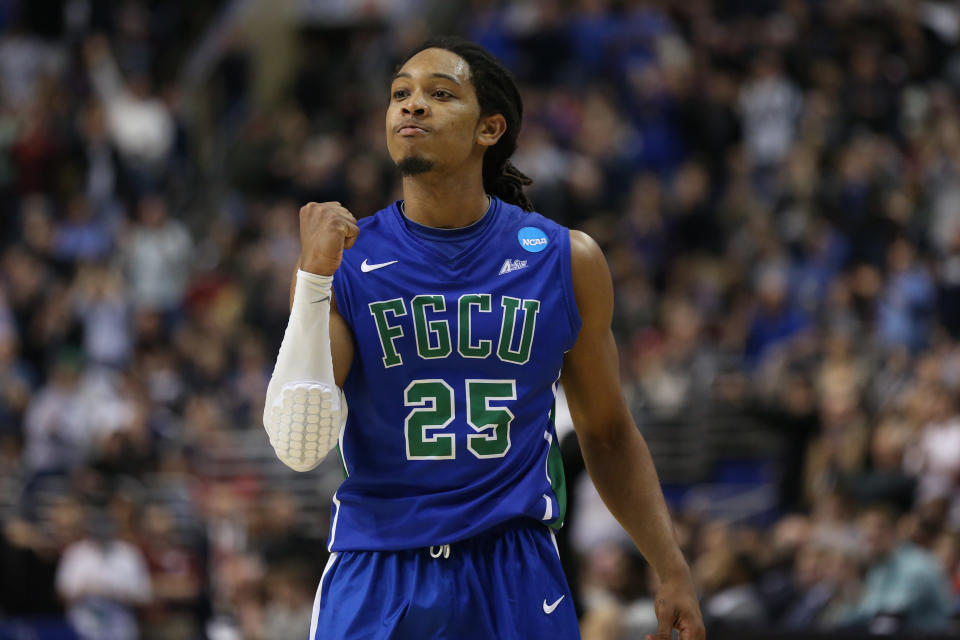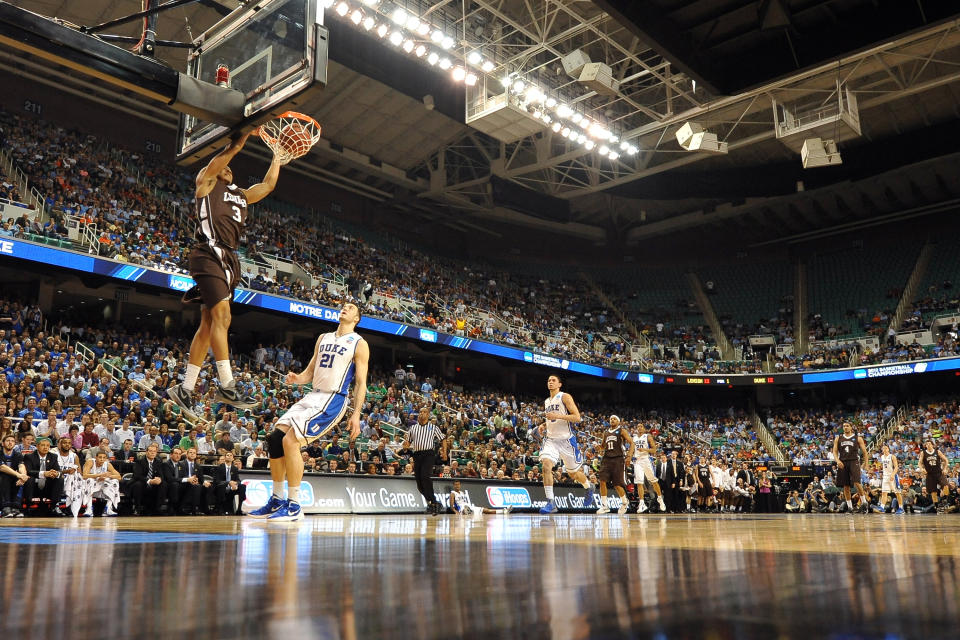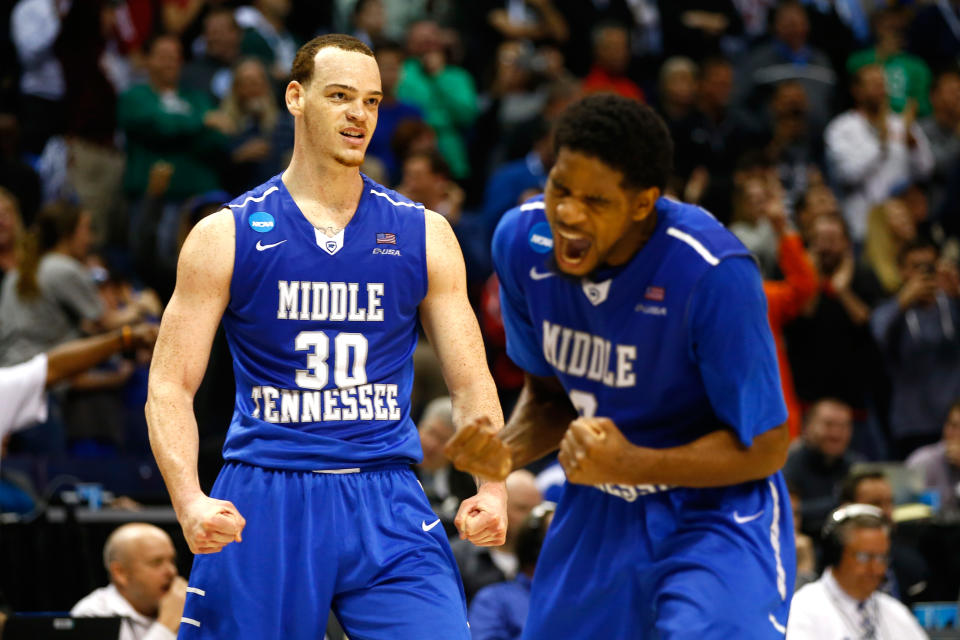How much money is an NCAA tournament upset worth to the winning school?
As the Lehigh men’s basketball team celebrated its biggest victory in program history, senior associate athletic director Bill Griffin was on the phone dealing with an unexpected crisis.
A tidal wave of traffic threatened to overwhelm the university’s athletics website after the Mountain Hawks toppled heavily favored Duke in the opening round of the NCAA tournament six years ago.
“We typically have about 4,000 visitors per day,” Griffin said. “That day, we got about 40,000 in one half-hour window. If you went on LehighSports.com, the page would take minutes to load and there were signs of the site crashing. We had to hustle to reroute communications lines, pull our site onto its own server and get it stable and accessible again.”
For a small-conference program able to punch above its weight class, an opening-round NCAA tournament upset achieves much more than just boosting school pride. Toppling one of college basketball’s heavyweights can bolster ticket and merchandise sales, produce a spike in alumni donations and generate tens of millions of dollars worth of media exposure.
To estimate the value of an opening-round NCAA tournament upset, Yahoo Sports studied the financial impact of four earth-shaking victories: 15th-seeded Lehigh over Duke (2012), 15th-seeded Florida Gulf Coast over Georgetown (2013) 14th-seeded Georgia State over Baylor (2015) and 15th-seeded Middle Tennessee over Michigan State (2016). Below is a look at how those upsets have benefited the victorious universities in unforeseen and far-reaching ways and helped each of them rise in stature.
[It’s bracket time! Sign up now to play Tourney Pick’em now]

MEDIA EXPOSURE
After Middle Tennessee stormed to a 15-2 lead a few minutes into its 2016 matchup with heavily favored Michigan State, Andrew Oppmann began to split his attention between the game and another screen tracking mentions of the Blue Raiders on social media in real time.
The longer Middle Tennessee held its lead, the more Oppmann couldn’t believe his eyes.
Middle Tennessee was the No. 1 trending topic on Twitter during the closing minutes of its 90-81 win over a Michigan State team considered one of the favorites to win the national title that season. Among the luminaries who tweeted about the game were Michigan State legend Magic Johnson, Murfreesboro native David Price and, oddly enough, the Denver Broncos.
Sports Illustrated called Middle Tennessee’s victory the biggest upset in the history of the NCAA tournament. ESPN’s Dick Vitale declared it “one of the all-time shockers.” Media coverage of the upset was so widespread that Middle Tennessee’s brand reach extended to far-flung countries like Liechtenstein, Kenya, Norway and Andorra.
“The instantaneous viral nature of this upset was like watching a rocket blast off in front of you,” said Oppmann, Middle Tennessee’s vice president of marketing and communications. “It’s a remarkable thing to behold. We can try to assess the value of the exposure, but from a brand awareness standpoint, it’s priceless. It’s not something money can buy.”
The size of the NCAA tournament’s audience hit home for Lehigh administrators when Justin Bieber tweeted about star guard C.J. McCollum’s 30-point performance in their victory over Duke. “That guy on Lehigh was for real,” Bieber wrote right after the game, and you have to admit the Biebs has an eye for talent.
To quantify the boost in brand awareness that an NCAA tournament upset can provide, Yahoo Sports asked the media intelligence company Meltwater to examine the volume and potential reach of the media coverage received by Lehigh, Florida Gulf Coast, Georgia State and Middle Tennessee. What Meltwater found underscored what an NCAA tournament win can do for a lesser-known school.
Fifty-nine percent of the university-wide media coverage Florida Gulf Coast received in 2013 came during March, providing the school more than $300 million worth of free publicity. Only Lehigh didn’t generate at least a quarter of its annual media coverage the month of its upset, and that’s only because of the unfortunate publicity bump the school received later that year from the tragic death of NFL coach Andy Reid’s son on its campus.

“The numbers would look different if you were to do this for a big football school like Alabama, but for smaller schools, a win in the NCAA tournament can be huge,” said Johnny Vance, director of strategic programming at Meltwater. “Nothing is bigger over the course of a year than what a week or two of basketball coverage is able to do for the school.”

FRESHMAN APPLICATIONS
For universities thrust into the national spotlight after an NCAA tournament upset, the major advantage of the increased publicity is the rise in freshman applications that typically follows.
Curious prospective students and their families often seek out more information about the school that just busted their brackets and in the process discover that the university has more to offer than just basketball.
The two highest traffic days in the history of Georgia State’s athletics website were when the Panthers stunned third-seeded Baylor on March 19, 2015 and when their run ended against 11th-seeded Xavier two days later. More than 400,000 visitors stopped by the site over the course of those two days to learn more about the school whose coach tumbled off his stool while celebrating his son’s game-winning jumper to beat the Bears.
The impact of that extra attention was clear the following school year when applications began arriving at record pace. Freshman applications to Georgia State increased 28.5 percent for the 2016-17 school year and the acceptance rate increased 17.4 percent.
“The cliche is that you can’t buy the kind of exposure we got from that win, but it’s true,” Georgia State athletic director Charlie Cobb said. “It gave Georgia State an advertising vehicle it had never had before. For the next two or three weeks, we turned Ron and R.J. Hunter into folk heroes. Everyone is looking for the great story, and the father-son moment was something you can’t script.”
For the other schools that pulled off massive recent upsets, the ensuing spike in applications was unmistakable too. Lehigh received a 9.2 percent increase in freshman applications the year after the Duke victory, Middle Tennessee enjoyed a 16.9 percent rise and Florida Gulf Coast was higher still at 27 percent.
While all the schools received a higher percentage of out-of-state applicants than normal because of the sudden jolt in national publicity, nowhere was that more true than Florida Gulf Coast. High school students hailing from the cold-weather Midwest were tantalized by the idea of attending a college situated in a South Florida vacation town and featuring dorms that overlook a beach on a lake.
“We had a shot in enrollment that at least in part was driven from people in Michigan, Ohio and other places that not only saw the basketball team but a lovely place to be in the winter too,” Florida Gulf Coast president Michael Martin said.
“I’ve got a really good friend I went to college with. He and his wife were sitting in the Minneapolis airport waiting to get on a plane recently, and they noticed a young man in an FGCU cap and shirt. They introduced themselves, and he said since that 2013 run he’s wanted to go to FGCU. So it’s one of those things that has stuck around and continues to have residual impact that’s pretty meaningful.”

ALUMNI DONATIONS, TICKET AND MERCHANDISE SALES
When Middle Tennessee upset Michigan State two years ago, its school bookstore received a surprising number of online orders from customers with Ann Arbor mailing addresses.
Turns out a bunch of Michigan fans figured that wearing Middle Tennessee caps and T-shirts around town was the ideal way to rub the upset in the faces of their friends who support Michigan State.
“For a moment in time, Ann Arbor Michigan was the No. 2 place in the country to find MTSU gear,” Oppmann said. “We definitely enjoyed some benefit of the Michigan-Michigan State rivalry.”
The phenomenon of purchasing T-shirts to commemorate a rival’s loss contributed to an immediate spike in merchandise sales at all four universities. For Lehigh, it was modest — $20,000 to $30,000. For Florida Gulf, it was massive — a nearly $500,000 increase in sales in March 2013 compared to March 2012.
A bump in attendance the following season has also been typical for giant-slaying NCAA tournament underdogs. Lehigh and Middle Tennessee enjoyed moderate increases, but attendance at Florida Gulf Coast home games nearly doubled after the Eagles’ coined the nickname “Dunk City” while becoming the first No. 15 seed ever to reach the Sweet 16.

The hallmark of Florida Gulf Coast’s bigger crowds is more graying hair than you typically find at a college basketball game. Many elderly Midwestern couples who come to Florida for the winter have taken an interest in Florida Gulf Coast basketball since 2013.
“Even at my age, when I walk into the building, I lower the average age,” the 71-year-old Martin said. “We’ve got this mass of fans who live in all these retirement communities and are now season ticket holders. They show up rabidly enthusiastic and many of them become donors despite the fact they’re not alums. So clearly that run and that year gave us appeal to people who have now become part of the Eagle family in a very significant way.”
Indeed, nothing inspires donors to reach for their checkbooks quite like winning.
Florida Gulf Coast doubled its number of alumni donors in a year after its Sweet 16 run. Donors at Lehigh gave $454,782 dollars more the year of the Duke win than the previous school year.

TOTAL VALUE
Ask administrators at any of the four universities to provide a ballpark total figure on what their NCAA tournament upset has been worth, and they all struggle to come up with an answer.
“I don’t know how you put a dollar value on it'” Lehigh athletic director Joe Sterrett said.
“We tried to do an assessment, but it was pointless,” Cobb, the Georgia State athletic director, said.
“I don’t know if there’s a measurement scale out there that can record how wonderful this has been,” Oppmann added.
It is indeed difficult to pinpoint a single total value because it’s clear the number differs based on the shock value of the upset, the appeal of the underdog and the stature of the team that’s beaten. Those factors combine to determine how much media exposure a school generates, how big a bump in freshman applications follows and how transformative the upset becomes.
What’s inarguable is that the the value of a single NCAA tournament upset is high enough that teams who score one often reinvest millions in pursuit of another.
Georgia State recently built a new basketball practice facility. Middle Tennessee gave coach Kermit Davis a raise and a contract extension. Florida Gulf Coast invested in luxury suites for its arena, an academic center for its players and new offices for its coaches.
For a small-conference program, the lone downside to NCAA tournament success is raised expectations.
Florida Gulf Coast has averaged 23 victories per season since its 2013 Sweet 16 run, but that has not been enough to satisfy everyone. Athletic director Ken Kavanagh recently overheard a student explain to a friend why he didn’t plan to attend an upcoming home game.
“He said, “‘Well, you know, we haven’t been to the Sweet 16 in a few years,'” Kavanagh said with a chuckle. “Really, that came out of the kid’s mouth. It was the old what have you done for me lately.”
– – – – – – –
Jeff Eisenberg is a college basketball writer for Yahoo Sports. Have a tip? Email him at daggerblog@yahoo.com or follow him on Twitter!



